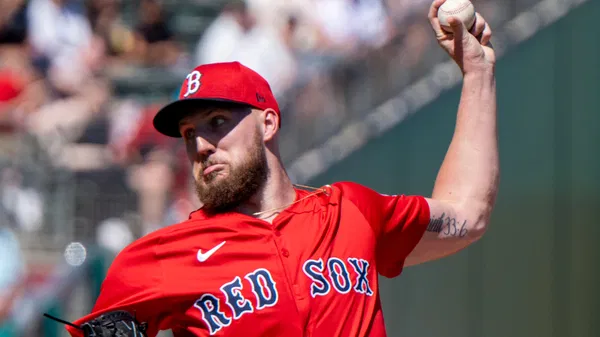

Committing nine figures to a pitcher is always open to heavy scrutiny in baseball, particularly when for a younger arm with relatively little starting experience. The Boston Red Sox made a big statement when they threw a $170 million bet. The long-term contract, announced just days into the 2025 season, was a huge faith in the young southpaw. But when his early performances failed to immediately quiet all questions about the investment, pressure mounted on the organization’s leadership to confirm their bold call.
The Red Sox finalized a six-year, $170 million extension with Garrett Crochet, extending him through 2031, just months after the team acquired him from the White Sox in December 2024. Starting in 2026, the deal will include Cy Young escalators that could increase its maximum total value, a player opt-out after 2030, and a conditional club option based on future health.
That massive deal generated instant criticism, particularly since Crochet was still settling in. This led Sam Kennedy, the president and CEO of the Red Sox, to briefly defend the team’s massive purchase. Kennedy summed up the organization’s ambitious mindset in four simple words: “We’re hungry for more.” His statement came following Crochet’s Red Sox debut—a decent, if unremarkable, outing against the Texas Rangers on March 28 (5 innings, 2 earned runs).
ADVERTISEMENT
Article continues below this ad
Red Sox Ace Garrett Crochet on his $170M Contract Extension |Red Sox Press Conference https://t.co/vBrr7K0OrU
— NESN (@NESN) April 4, 2025
The “rocky start” label applied to Crochet was based mainly on comparing that solid debut against Texas to his modest, up-and-down spring training. During March, the talented southpaw posted a troubling 4.50 ERA with a high 1.58 WHIP over just 12 innings pitched across five starts. Though his regular-season debut showed improved ERA (3.60) and WHIP (1.20) numbers, his strikeout rate dropped significantly compared to spring training (from 11.25 K/9 down to 7.20 K/9). That slight drop, along with durability concerns following brief spring appearances, sparked early doubts about his massive new contract.
The pitcher appears quite determined to prove Boston right, demonstrating a burning desire to succeed. He has expressed his desire for the organization to be the place where he can “run myself into the ground … give everything I have to this season.” Chief Baseball Officer Craig Breslow echoed this confidence, calling Crochet a “legitimate No. 1 starter” when they acquired him and stating that the “best is still in front of him.” The Red Sox and Crochet remain optimistic, but baseball history is filled with cautionary tales about massive contracts for pitchers.
From reliever to ace: Can Garrett Crochet deliver for the Red Sox?
Remember when Barry Zito’s seven-year, $126 million Giants deal in 2006 resulted in a 4.62 ERA? Or Mike Hampton’s eight-year, $121 million Rockies deal in 2000? Even Chan Ho Park’s five-year, $65 million Rangers deal in 2002 ended in injuries and underperformance. This history highlights the inherent risk that comes with any long-term, high-value pitching investment like Boston’s $170 million bet.
What’s your perspective on:
Did the Red Sox gamble too soon on Crochet, or is this a genius move in the making?
Have an interesting take?
But the bet is not blindfolded after all. Crochet’s journey to becoming Boston’s potential rotation anchor has been nothing short of spectacular. Selected 11th overall by the Chicago White Sox in 2020, the electric lefty was remarkably fast-tracked to the majors that year, where he excelled as a reliever. After undergoing Tommy John surgery that sidelined him for all of 2022, he made a surprising transformation into a dominant starting pitcher in 2024. The talented southpaw had a 3.58 ERA while leading with 209 strikeouts, earning himself his first All-Star selection before the big off-season trade, which helped bring his electric arm to Fenway Park.
ADVERTISEMENT
Article continues below this ad

Crochet’s arrival seemed especially needed in Boston due to their shaky pitching start to the 2025 season. Although Crochet pitched brilliantly in his second start, other rotation members like Tanner Houck (6.52 ERA) and offseason acquisition Walker Buehler (8.31 ERA) struggled significantly in their outings. The bullpen also exhibited cracks early, as Justin Slaten posted a 12.00 ERA, magnifying concerns while Brayan Bello remained sidelined.
ADVERTISEMENT
Article continues below this ad
Crochet steps into this instability, likely becoming Boston’s number one starter and inheriting the ace crown previously held by Houck. He now leads a rotation that will include Houck, Buehler, and a hopefully soon-returning Bello, with either Richard Fitts or Kutter Crawford likely rounding it out. Expectations are sky-high for the young lefty: deliver consistent ace-level production and lead the charge back to playoff contention. Can Crochet handle the pressure and be the dominant force the Red Sox require this season?
Have something to say?
Let the world know your perspective.
ADVERTISEMENT
ADVERTISEMENT
ADVERTISEMENT
ADVERTISEMENT



Did the Red Sox gamble too soon on Crochet, or is this a genius move in the making?